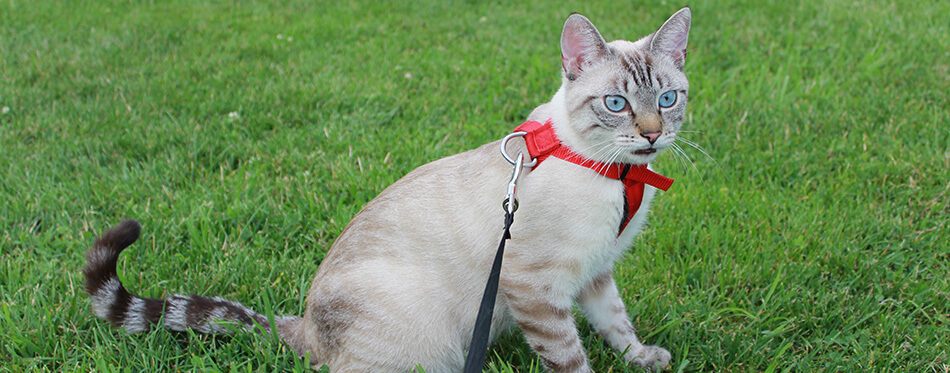Many people assume that because they’ve only ever known cats to wander around freely, that letting them out of the house unattended is the only way to give them exercise. This couldn’t be more wrong! There is a large number of activities that a cat can do to get their daily exercise and engagement that have proved far less dangerous than wandering the street at their own whim. And one way that a lot of people don’t ever think of, a way which has been used for dogs for centuries, is cat leash walking. If you’re unsure how to walk a cat on a leash, but would like to learn how then this is the place for you.
What is a Cat Leash?
A cat leash and harness is a far safer alternative to free-roaming and a fantastic way to keep tabs on your cat, especially in their earlier more adventurous stages. Much like a dog leash and harness it typically consists of a comfortable (relatively loose-fitting) body harness and a leash to attach it to. The use of a cat leash has proven to significantly extend a cat’s life expectancy, as they don’t have the danger of wandering into the road or getting their ID collar stuck on something, unable to escape. For more options head over to our guide on cat collars.

Should I Walk my Cat on a Leash?
Every feline family member has its own personality, much like humans. The cat on leash method may not suit every cat, just the same as some dogs walk better off the leash than on it. However, walking cats on leashes can still be a general training device combined with additional training methods such as clicker training, or positive reinforcement with treats. Find out more about cat treats here.
Which Cats will Benefit Most?
There are however some cats that would benefit more from the use of a cat harness and leash, such as:
- House cats: A house cat, which has only ever known the inside of your home may find the outdoors to be overwhelming. In this instance, the cat walk method, starting with the garden and working your way out, would be a safe effective way of introducing them to the outside world.
- Kittens: Sometimes training is best done when your feline friend is still a kitten so that they grow to know what the harness is like, and therefore are less likely to fight against any new training, and more likely to stay near to home if they do decide to go on one of their own cheeky little unaccompanied walks.
- Bored cats: If a cat is struggling with boredom, they can turn to alternative means of entertaining themself, which can be destructive and disruptive, especially if they get bored of their climbing tower and start leaping from the windows and eyeing up the door as a fantastic new cat scratching post! These walks are a great way to engage them, exercise out some of their pent up energy, and encourage better behavior.
Is the Harness only for Kittens?
Where it may be best to introduce it at a young age, there’s no harm in trying cat leashes with more adult cats too, who says “you can’t teach an old dog new tricks”? They may be more apprehensive about the new experience, that just means it will be a slower process, but not impossible!
Where to Start with Leash Walking?
I realize that a change as big as walking your cat can feel a teeny bit like a mammoth task, but you just have to take it one step at a time. And they are very small steps indeed, so don’t feel discouraged if it seems to be taking longer than you expected, it just requires a bit of patience.
Finding the Best Fit for You and Your Kitty
Something that is absolutely crucial to the success of your outdoor endeavor is picking the best harness. Every cat has a different shape, different fur, and different preferences. You may find yourself trying a few different types before you get the right fit, but it will always be worth it in the long run! I’d suggest checking out some cat harness reviews before committing to a design to stand the best chance of finding the right one straight away.
Introducing Them to the New Equipment
There are a few recommended approaches to the leash walking training process, but it seems the best way is to move at a glacial pace to start with. First, let them simply get used to the equipment itself.
- Let them see it for themselves: before you start trying to place an unfamiliar object around their body, it’s worth letting them look it over for themselves. So start by placing the harness and lead down on the ground and allowing them to sniff, bat, and generally engage with it.
- remember positive reinforcement: If you are also training with treats and a clicker, this would be an excellent time for a bit of positive reinforcement. Reward their engagement by providing a click and treat for each interaction with it, so that they will feel compelled to want to be around it again.
Getting Them Used to the Feel of a Harness
Once you are sure that they are comfortable in the presence of the harness, it’s time to try it on. Slowly place your cat in the harness, trying not to move too quickly lest you send them bolting for the door. Be sure to give them plenty of treats throughout the process! Repeat this process as much as you need to, making sure to give your cat time to adjust to the feel of it once it’s on, don’t forget cats are highly sensitive creatures.
Let’s Start at the Very Beginning, a Very Good Place to Start!
Now that your kitty has adapted to the general feel and experience of the harness, it’s time to step up the game and attach the leash! The best way to start is to gently start walking your cat around the living room, again keeping up the treats and rewards. A walk around the living room or kitchen will slowly get them used to what it feels like for your cat to walk on a leash. Only when they seem comfortable with this stage do you move on to the next.
Now it’s Time for the Real Fun to Begin!
This is where all of the effort, the treat training, the time spent getting them used to the harness and leash, you finally get to try out your cat leash outside! So get your cat ready to go and head out into the garden. Now that they are familiar with what it’s like to walk on a leash, they get to start exploring their surroundings. Again, take it easy. This is all very new to the, and if your cat only makes it to the end of the garden, that’s okay! At the end of the day you have taught your cat to walk on a leash and that’s a tremendous accomplishment.
Where to Now?
Since the cat leash by now has proven successful, you can look to hire a cat walker, someone who walks cats on leash regularly, someone you can trust to care of them, whilst you are freed up for other tasks. So even when they lose their ID tag, you know they’re not going anywhere!

How to Ensure They Experience the Outdoors Safety
Before taking them into the big wide world, always ensure that your cat is fully vaccinated and prepared to take on the parasites and other risks that come with it. A flea collar wouldn’t go amiss either!
Additional Uses for the Leash and Harness
By using a mixture of the harness and leash as an additional device with the click and treat method you can teach your cat to respond to your call. Recall is always a handy trick to have with any pet!
Is This the Best Choice for my Cat?
Cat walking has grown in popularity over time, as people realize that they really are the best option when it comes to a kitties’ safety. And by developing a routine with this device you can ensure that they are supervised and protected outdoors, whilst still exploring the world around them and enjoying their own adventures. This form of training and exercise may not be for you, but it could never hurt to give it a try when walking a cat instead can make such a big difference to their life.
Source:
- Fettered felines: Take your cat for a walk outside – The Humane Society

